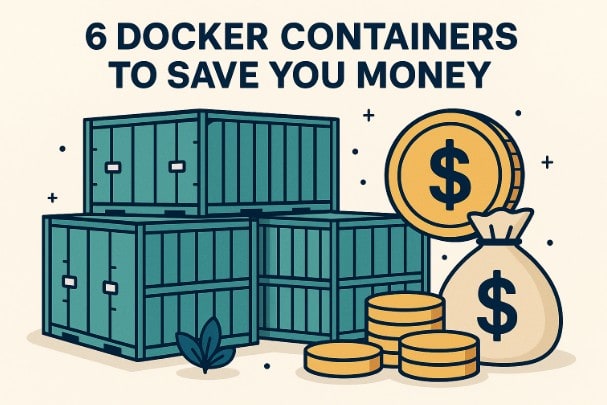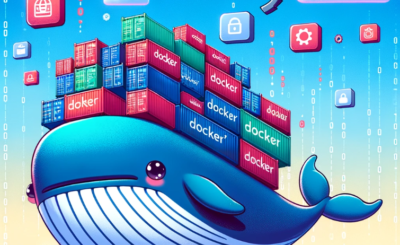In the world of IT, cost optimization is paramount. For DevOps engineers, cloud architects, and system administrators, managing infrastructure efficiently translates directly to saving money. This article explores 6 Docker containers that can significantly reduce your operational expenses, improve efficiency, and streamline your workflow. We’ll delve into practical examples and demonstrate how these containers deliver substantial cost savings.
Table of Contents
- 1 1. Lightweight Databases: PostgreSQL & MySQL
- 2 2. Caching Solutions: Redis & Memcached
- 3 3. Web Servers: Nginx & Apache
- 4 4. Message Queues: RabbitMQ & Kafka
- 5 5. Log Management: Elasticsearch, Fluentd, and Kibana (EFK Stack)
- 6 6. CI/CD Tools: Jenkins & GitLab Runner
- 7 Frequently Asked Questions (FAQ)
- 7.1 Q1: Are Docker containers really more cost-effective than virtual machines (VMs)?
- 7.2 Q2: What are the potential downsides of using Docker containers for cost saving?
- 7.3 Q3: How do I choose the right Docker image for my needs?
- 7.4 Q4: How can I monitor resource usage of my Docker containers?
- 7.5 Q5: What are some best practices for securing my Docker containers?
- 8 Conclusion 6 Docker Containers to Save You Money
1. Lightweight Databases: PostgreSQL & MySQL
Reducing Server Costs with Containerized Databases
Running full-blown database servers can be expensive. Licensing costs, hardware requirements, and ongoing maintenance contribute to significant operational overhead. Using lightweight Docker containers for PostgreSQL and MySQL provides a cost-effective alternative. Instead of dedicating entire servers, you can deploy these databases within containers, significantly reducing resource consumption.
Example: A small startup might require a database for development and testing. Instead of provisioning a dedicated database server, they can spin up PostgreSQL or MySQL containers on a single, more affordable server. This approach eliminates the need for separate hardware, saving on server costs and energy consumption.
Code Snippet (Docker Compose for PostgreSQL):
version: "3.9"
services:
postgres:
image: postgres:15
ports:
- "5432:5432"
environment:
- POSTGRES_USER=myuser
- POSTGRES_PASSWORD=mypassword
- POSTGRES_DB=mydb
Scaling and Flexibility
Docker containers provide unparalleled scalability and flexibility. You can easily scale your database horizontally by deploying multiple containers, adjusting resources based on demand. This eliminates the need for over-provisioning hardware, resulting in further cost savings.
2. Caching Solutions: Redis & Memcached
Boosting Performance and Reducing Database Load
Caching solutions like Redis and Memcached dramatically improve application performance by storing frequently accessed data in memory. By reducing the load on your database, you reduce the need for expensive high-end database servers. Containerizing these caching solutions offers a lightweight and cost-effective method to integrate caching into your infrastructure.
Example: An e-commerce application benefits significantly from caching product information and user sessions. Using Redis in a Docker container reduces the number of database queries, improving response times and lowering the strain on the database server, ultimately reducing costs.
Code Snippet (Docker run for Redis):
docker run --name my-redis -p 6379:6379 -d redis:alpine
3. Web Servers: Nginx & Apache
Efficient Resource Utilization
Traditional web servers often require dedicated hardware. By containerizing Nginx or Apache, you can achieve efficient resource utilization. Multiple web server instances can run concurrently on a single physical server, optimizing resource allocation and minimizing costs.
Example: A high-traffic website might require multiple web servers for load balancing. Using Docker allows you to deploy many Nginx containers on a single server, distributing traffic efficiently and reducing the need for expensive load balancers.
4. Message Queues: RabbitMQ & Kafka
Decoupling Applications for Improved Scalability
Message queues like RabbitMQ and Kafka are essential for decoupling microservices, enhancing scalability, and ensuring resilience. Containerizing these message brokers provides a flexible and cost-effective way to implement asynchronous communication in your applications. You can scale these containers independently based on messaging volume, optimizing resource usage and reducing operational costs.
Example: In a large-scale application with numerous microservices, a message queue manages communication between services. Containerizing RabbitMQ allows for efficient scaling of the messaging system based on real-time needs, preventing over-provisioning and minimizing costs.
5. Log Management: Elasticsearch, Fluentd, and Kibana (EFK Stack)
Centralized Logging and Cost-Effective Monitoring
The EFK stack (Elasticsearch, Fluentd, and Kibana) provides a centralized and efficient solution for log management. By containerizing this stack, you can easily manage logs from multiple applications and servers, gaining valuable insights into application performance and troubleshooting issues.
Example: A company with numerous applications and servers can leverage the EFK stack in Docker containers to centralize log management. This reduces the complexity of managing logs across different systems, providing a streamlined and cost-effective approach to monitoring and analyzing logs.
6. CI/CD Tools: Jenkins & GitLab Runner
Automating Deployment and Reducing Human Error
Automating the CI/CD pipeline is crucial for cost-effectiveness and efficiency. Containerizing CI/CD tools such as Jenkins and GitLab Runner enables faster deployments, reduces manual errors, and minimizes the risk of downtime. This results in significant cost savings in the long run by improving development velocity and reducing deployment failures.
Example: Using Jenkins in a Docker container allows for seamless integration with various build and deployment tools, streamlining the CI/CD process. This reduces manual intervention, minimizes human error, and ultimately reduces costs associated with deployment issues and downtime.
Frequently Asked Questions (FAQ)
Q1: Are Docker containers really more cost-effective than virtual machines (VMs)?
A1: In many scenarios, yes. Docker containers share the host operating system’s kernel, resulting in significantly lower overhead compared to VMs, which require a full guest OS. This translates to less resource consumption (CPU, memory, storage), ultimately saving money on hardware and infrastructure.
Q2: What are the potential downsides of using Docker containers for cost saving?
A2: While Docker offers significant cost advantages, there are some potential downsides. You need to consider the learning curve associated with Docker and container orchestration tools like Kubernetes. Security is another crucial factor; proper security best practices must be implemented to mitigate potential vulnerabilities.
Q3: How do I choose the right Docker image for my needs?
A3: Selecting the appropriate Docker image depends on your specific requirements. Consider the software version, base OS, and size of the image. Official images from reputable sources are usually preferred for security and stability. Always check for updates and security vulnerabilities.
Q4: How can I monitor resource usage of my Docker containers?
A4: Docker provides tools like `docker stats` to monitor CPU, memory, and network usage of running containers in real-time. For more advanced monitoring, you can integrate with monitoring platforms such as Prometheus and Grafana.
Q5: What are some best practices for securing my Docker containers?
A5: Employ security best practices like using minimal base images, regularly updating images, limiting container privileges, using Docker security scanning tools, and implementing appropriate network security measures. Regularly review and update your security policies.

Conclusion 6 Docker Containers to Save You Money
Leveraging Docker containers for essential services such as databases, caching, web servers, message queues, logging, and CI/CD significantly reduces infrastructure costs. By optimizing resource utilization, enhancing scalability, and automating processes, you can achieve substantial savings while improving efficiency and reliability. Remember to carefully consider security aspects and choose appropriate Docker images to ensure a secure and cost-effective deployment strategy. Implementing the techniques discussed in this article will empower you to manage your IT infrastructure more efficiently and save your organization serious money. Thank you for reading the DevopsRoles page!
